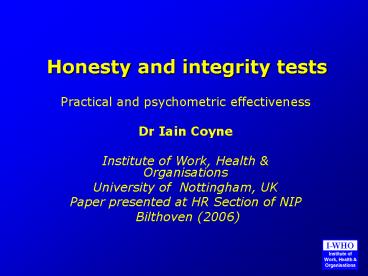Honesty and integrity tests - PowerPoint PPT Presentation
1 / 17
Title:
Honesty and integrity tests
Description:
Mean alpha = 0.81. Mean test-retest = 0.85. Fairness. Group differences - Ones & Viswesvaran (1998) ... Mean Alpha's of 0.81 and mean test-retest of 0.85. ... – PowerPoint PPT presentation
Number of Views:1889
Avg rating:3.0/5.0
Title: Honesty and integrity tests
1
Honesty and integrity tests
- Practical and psychometric effectiveness
- Dr Iain Coyne
- Institute of Work, Health Organisations
- University of Nottingham, UK
- Paper presented at HR Section of NIP
- Bilthoven (2006)
2
Outline
- History of integrity testing
- Types of integrity tests
- Quality issues
- scope, accuracy, fairness, acceptability
- Validity Meta-analyses
- Negatives
- Conclusions
3
History
- Been around since 1950s
- Saw an increase in use in US in 1980s
- Sensitisation as a result of scandals
- Employee Polygraph Protection Act
- Their use
- 5000 US organisations use them annually (Sackett
Harris, 1984) - 10-15 of all US employers (OBannon et al, 1989)
- 2.5 of UK personnel managers used integrity
tests to select for honesty (Coyne, 2001)
4
Types
Overt
Covert
Attitudes Admissions
Personality
Reid Report PSI
PRB Hogan Reliability Giotto
5
Scope
- Initially view them as specific as they only
measure integrity or related constructs
Specific
Broad
Overt
Covert
Theft
CWB
6
Accuracy
- Internal consistency
- 0.85 for Reid Report and PSI
- 0.73-0.97 for PRB
- 0.63 for Hogan Reliability Scale
- Test retest
- 0.91 on PSI over 1 week
- 0.90 for Hogan over 4 weeks
- Ones et al (1993) meta-analysis
- Mean alpha 0.81
- Mean test-retest 0.85
7
Fairness
- Group differences - Ones Viswesvaran (1998)
- Females 0.16 SDs higher than males
- Blacks 0.04 SDs lower than Whites
- 40 0.08 SDs higher than lt40
- Coyne (2001) 458 working adults
- Females 0.08 SDs lower than males
- Blacks 0.47 SDs higher than Whites
- 40 0.27 SDs higher than lt40
8
Fairness
- False positives
- Paradox of screening out honesty
- 50 of people may be incorrectly classified
(Murphy, 1993)
9
Acceptability
Single method
Multi-method
Appropriate to use Do not like it Only a small
sample refuse to take it Overt more job relevant
and less offensive/invasive than covert
Ranked around the middle when compared to other
methods. Not liked but not disliked
10
Validity
- Criterion
- External criteria
- 0.23 0.62 with various measures of dishonest
behaviour (theft, absenteeism etc) - Time series
- Theft and termination rates dropped after
introduction of IT - Contrasted groups
- dishonest groups perform worse than
non-dishonest
11
Meta-analysis Ones Viswesvaran (2001)
12
Schmidt Hunter (1998)
13
Schmidt Hunter (1998)
- GMA IT or GMA Structured interview
- Highest increase in utility
- Both can be used with entry-level or experienced
applicants - Both combinations are less expensive than other
combinations - Both measure in part conscientiousness which is
shown to relate to job performance
14
Negatives
Supervisor ratings
Labelling
Cross-culture?
Faking
Screen out managers
Personality is better
15
Personality better?
16
Summary
17
Conclusions
- Overall research has shown favourable evidence
for psychometric effectiveness of ITs - Need to consider labelling, faking, false
positive and acceptability - Personality scales and structured interviews also
show positive results - Need to consider training
- What about bad barrels?































